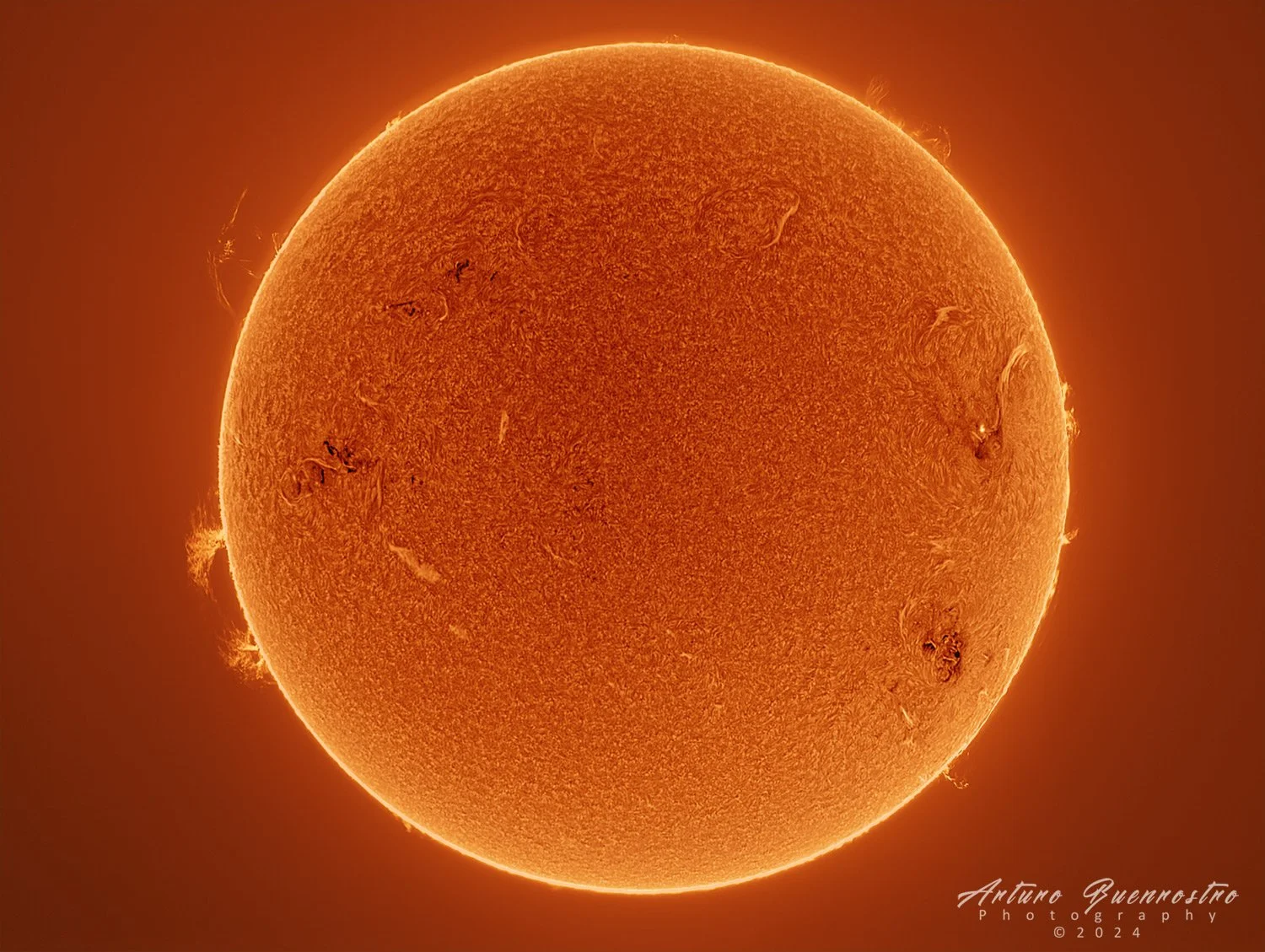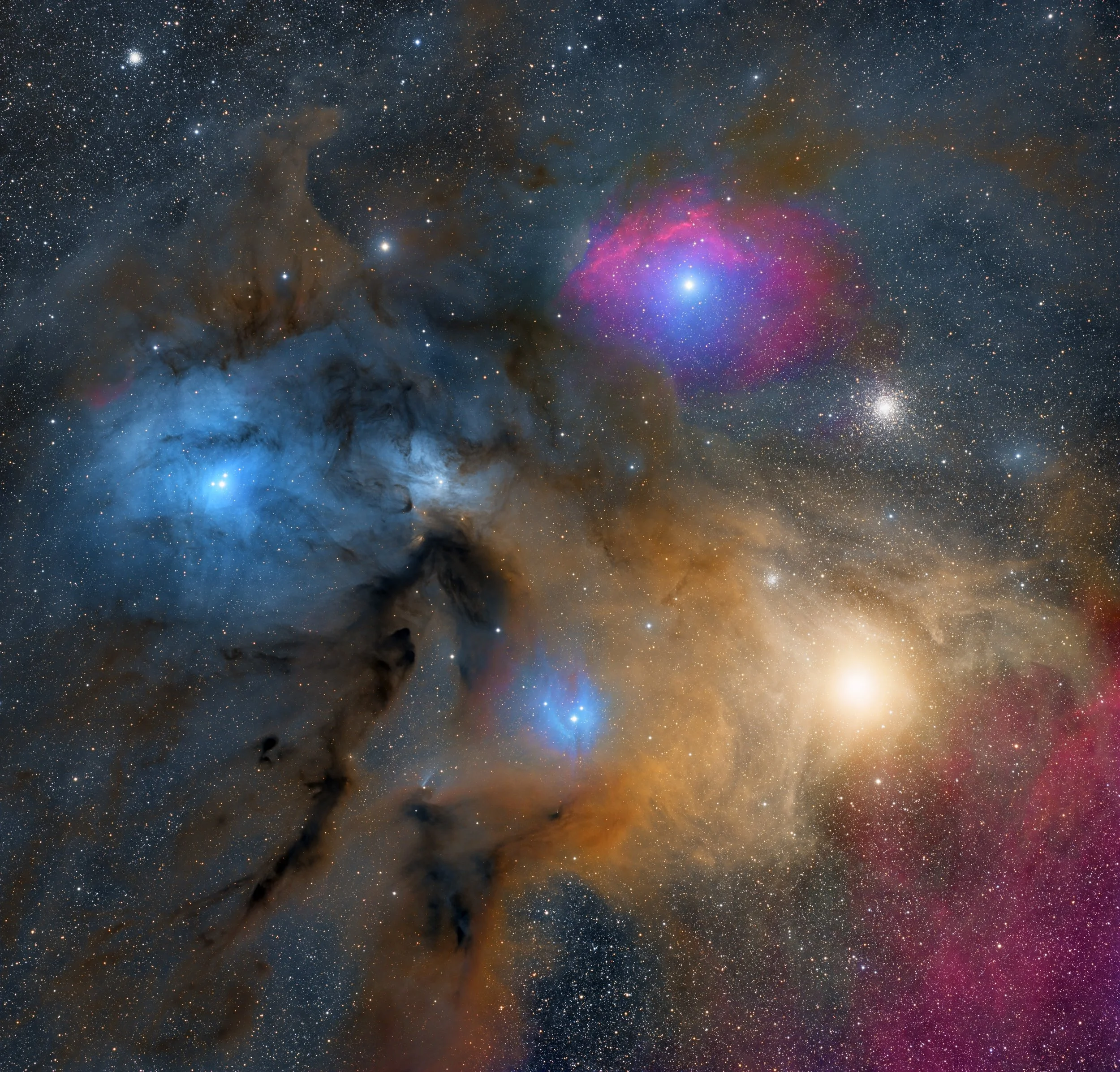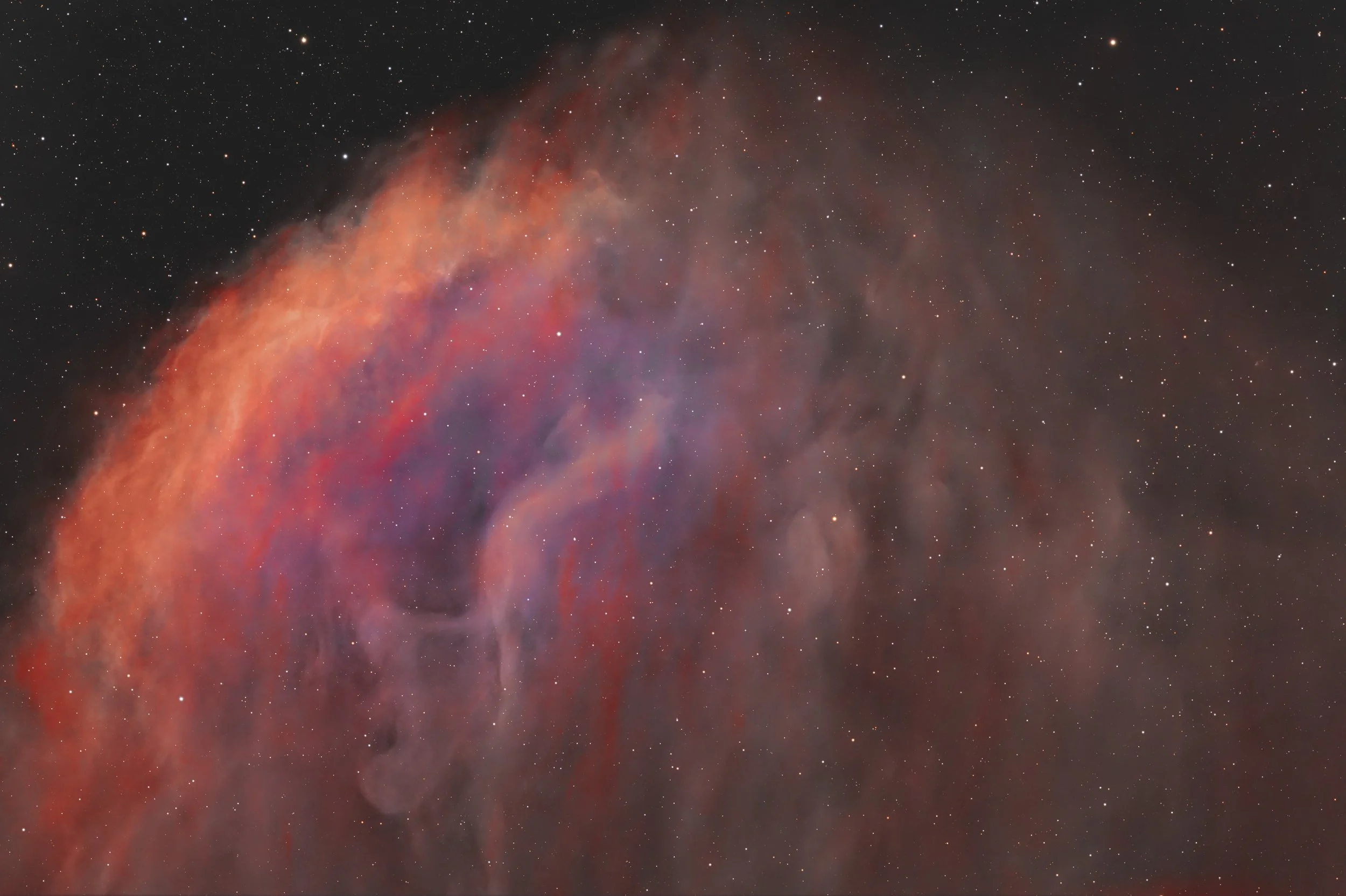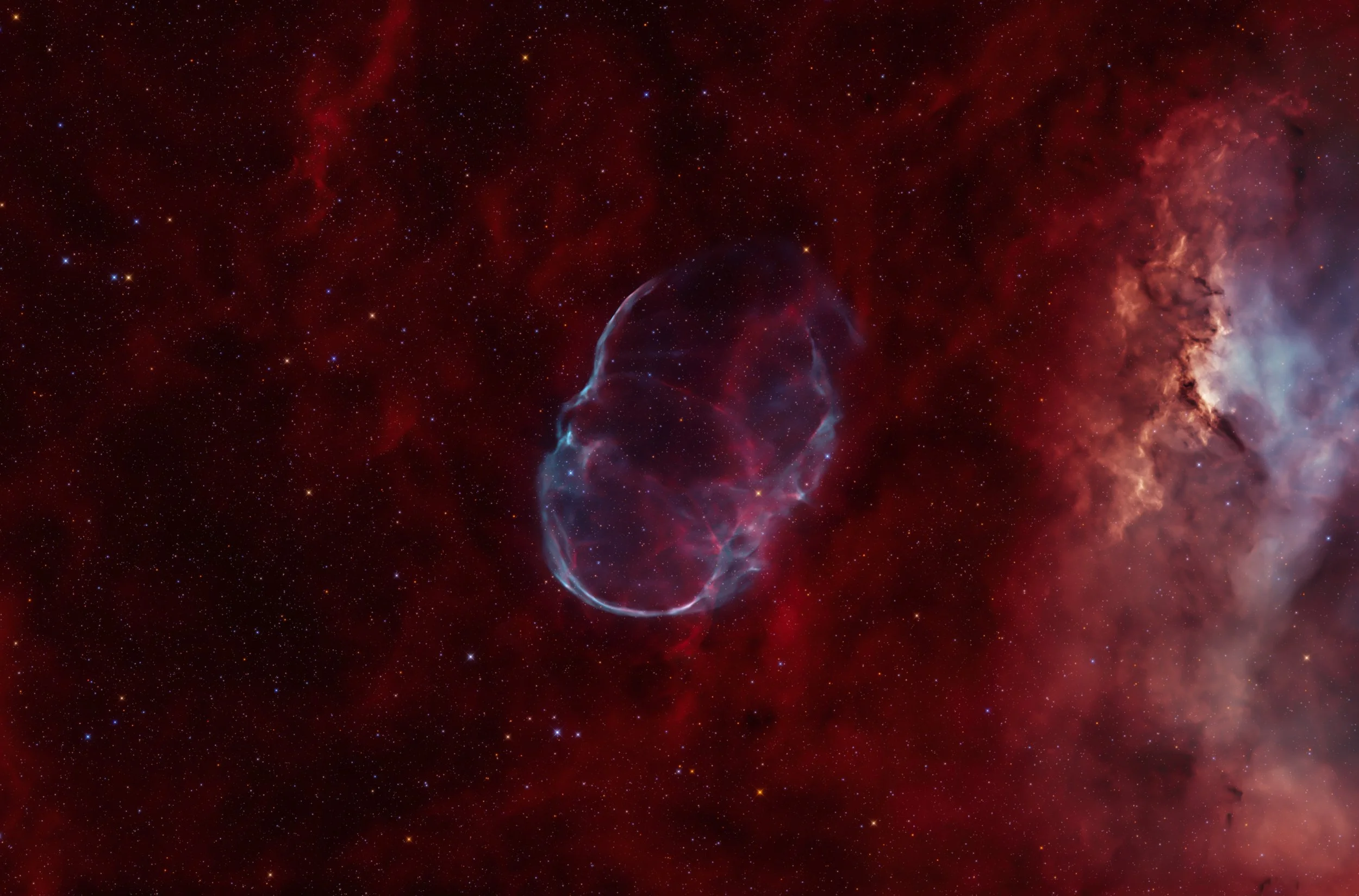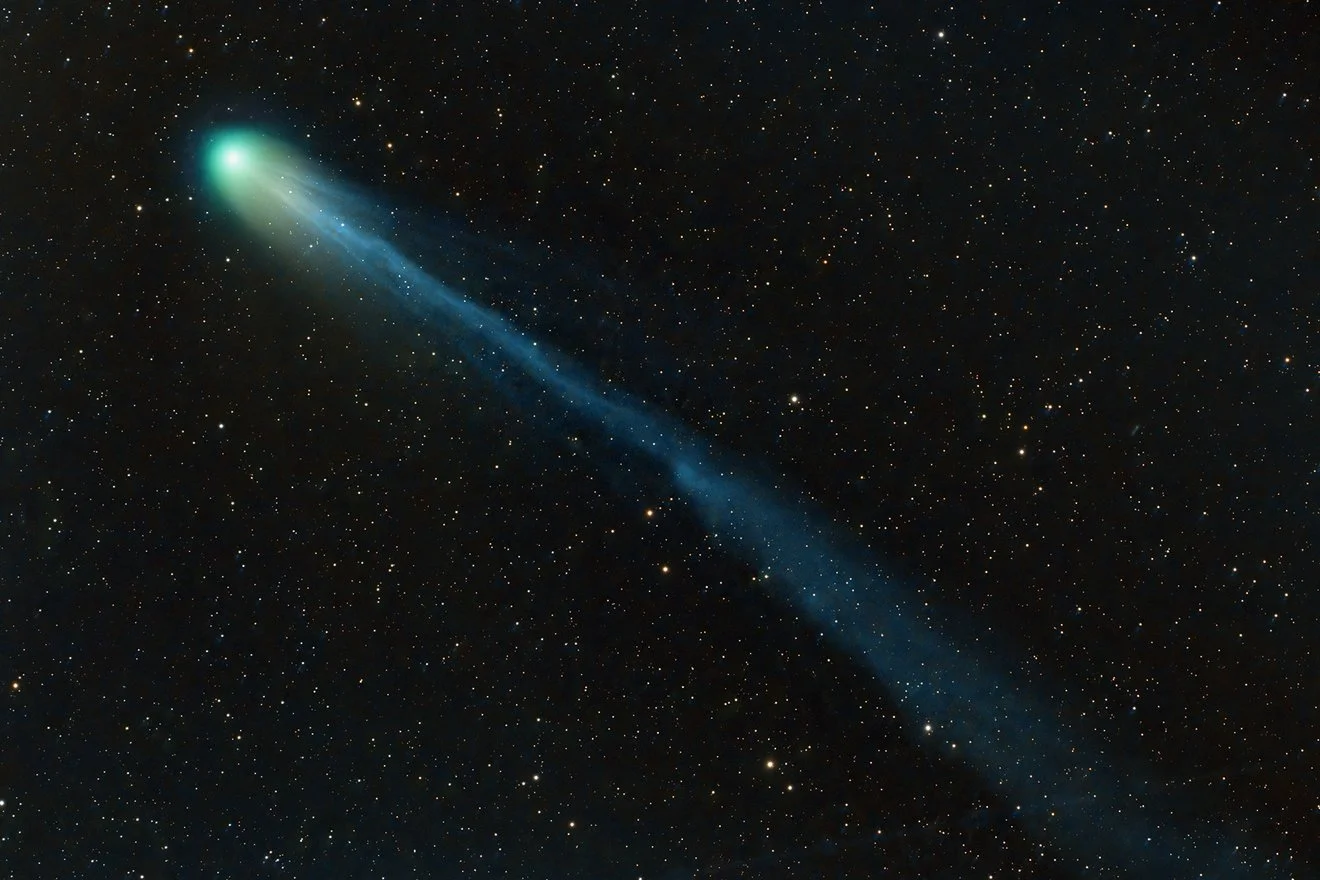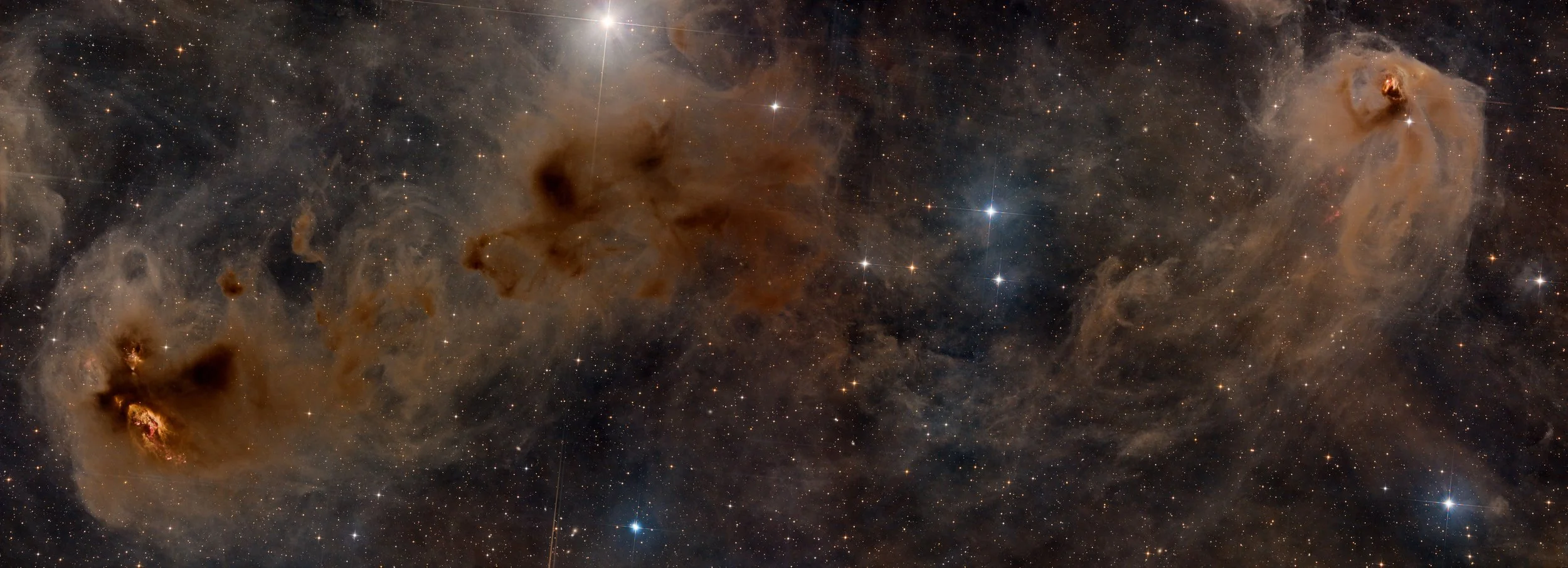
AAPOD2 Image Archives
Messier 100
Located in the constellation Coma Berenices, M100 is a grand design spiral galaxy approximately 55 million light-years away from Earth. With a diameter spanning over 100,000 light-years, it is one of the largest and brightest members of the Virgo Cluster of galaxies. M100 exhibits prominent spiral arms filled with young, hot stars, as well as dark dust lanes that trace the galaxy's structure. Its bright nucleus harbors a supermassive black hole, which is believed to play a crucial role in regulating the galaxy's growth and evolution.
Originally discovered by Pierre Méchain in 1781, M100 is celebrated for its exceptional beauty and rich astrophysical significance. It serves as a key object of study for astronomers seeking to understand the processes driving the formation and evolution of spiral galaxies. Through detailed observations and analysis, researchers have uncovered a wealth of information about M100's stellar population, star formation activity, and overall structure, contributing to our broader understanding of galactic dynamics and cosmology. As a captivating cosmic gem nestled within the vastness of the universe, M100 continues to inspire and intrigue observers with its timeless allure.
Before the eclipse
At the heart of our solar system, the Sun reigns supreme, illuminating and nurturing the planets that orbit around it. As a G-type main-sequence star, the Sun is a vast sphere of superheated plasma, primarily composed of hydrogen and helium. Its immense gravity holds the solar system together, while its radiant energy fuels life and drives the dynamic processes of our planet.
With a diameter of about 1.4 million kilometers (870,000 miles), the Sun is approximately 109 times larger than Earth, yet it appears as a relatively small, bright disc in our sky due to its vast distance of about 93 million miles (150 million kilometers) from Earth. Despite its seemingly tranquil appearance, the Sun is a dynamic and ever-changing celestial body, marked by features such as sunspots, solar flares, and coronal mass ejections. These phenomena are driven by the Sun's complex magnetic field, which interacts with its hot, turbulent outer layers known as the corona.
This image of the Sun was captured just 20 days before the solar eclipse of 2024, adding a poignant context to its portrayal. Taken with specialized solar observation equipment and precise imaging techniques, this photograph offers a glimpse into the Sun's intricate surface features and dynamic activity. It serves as a reminder of the Sun's ongoing role in shaping our world and the celestial events that capture our collective imagination.
northern tip of the Monoceros constellation
In the vicinity of Dreyer's Nebula, also known as NGC 2264, lie several other notable celestial objects, including the Cone Nebula and the Christmas Tree Cluster. While Dreyer's Nebula itself is a reflection nebula illuminated by the star S Monocerotis, the Cone Nebula is an adjacent dark nebula that appears as a distinctive cone-shaped feature against the backdrop of interstellar space. Nearby, the Christmas Tree Cluster, or NGC 2264, is a young stellar cluster embedded within a diffuse emission nebula, adding to the visual richness of the region.
Though these objects may vary in size and appearance, they collectively contribute to the captivating beauty of the cosmic landscape in this part of the sky. Together, they offer astronomers and stargazers a glimpse into the dynamic processes of star formation and interstellar sculpting, showcasing the intricate interplay between stars, gas, and dust in the vast expanse of the universe.
IC405 Ha-S2 narrowband
In the depths of the night sky lies the striking emission nebula known as IC 405, or the Flaming Star Nebula. Illuminated by the energetic radiation of its central star, AE Aurigae, this cosmic spectacle dazzles with vibrant hues of red and blue. The intricate tendrils of gas and dust stretch across the heavens, sculpted by the fierce stellar winds and intense radiation emanating from AE Aurigae. As hydrogen alpha and sulfur emissions interplay within the nebula, they create a captivating tapestry of light and shadow, offering astronomers a glimpse into the dynamic processes of star formation and stellar evolution.
IC 405 is a testament to the cosmic interplay between stars and the interstellar medium, where massive stars sculpt their surroundings while simultaneously seeding the cosmos with new generations of stellar offspring. As we behold the beauty of the Flaming Star Nebula, we are reminded of the intricate dance of creation and destruction that unfolds throughout the cosmos, shaping the vast tapestry of the universe with its celestial wonders.
Spectrum of Creation: The Rainbow Hues of The Seagull Nebula
In the cosmic expanse of the Monoceros constellation, the Seagull Nebula, or IC 2177, unfurls its majestic wings, captivating observers with its ethereal beauty. At its core, a brilliant young star illuminates the surrounding nebulous material, sculpting intricate patterns of light and shadow that resemble the graceful wings of a seabird in flight.
Within this celestial realm, stars are born from collapsing clouds of gas and dust, while aging stars shed their outer layers in dazzling displays of cosmic recycling. As astronomers peer into the depths of the Seagull Nebula, they uncover the secrets of stellar birth and evolution, offering insights into the intricate dance of creation and destruction that shapes the cosmos.
Bluis Centaurus A
In the depths of the cosmos, nestled within the constellation of Centaurus, lies the enigmatic galaxy known as Centaurus A, or NGC 5128. This celestial behemoth, shrouded in mystery and intrigue, offers a glimpse into the tumultuous dance of cosmic forces that shape the universe.
At the heart of Centaurus A lies a supermassive black hole, its insatiable appetite devouring surrounding matter and unleashing powerful jets of radiation into the cosmos. These jets, spanning thousands of light-years, paint a vivid portrait of the galaxy's dynamic nature, as it engages in a cosmic battle against the forces of gravity and entropy.
But Centaurus A is more than just a spectacle of cosmic violence. Embedded within its intricate structure are clues to the galaxy's turbulent past, including evidence of past collisions and mergers with smaller galaxies. These cosmic cataclysms have left behind a trail of stellar debris and gas, sculpting Centaurus A into the awe-inspiring sight we behold today.
Lunar encounter in French Alps
In the early hours of Wednesday, January 31, an extraordinary rendezvous unfolded between the Moon and the majestic Aiguille de Baude. As the first rays of dawn graced the summit of Aiguille de Baude, the Moon, ever the elusive companion, began its silent retreat, casting fleeting shadows across the rugged landscape.
Orion over Austrian Alps
In this captivating landscape image captured at Jägersee, Austria, the iconic constellation of Orion and the ethereal arc of Barnard's Loop adorn the velvety canvas of the night sky, casting their celestial glow over the rugged silhouette of the Austrian Alps. Amidst the towering peaks and mirrored waters of Jägersee, the celestial ballet unfolds, merging the timeless beauty of the cosmos with the earthly grandeur of the natural landscape.
The constellation of Orion, with its distinctive pattern of stars, including the bright trio of Orion's Belt, serves as a beacon in the night, guiding the observer's gaze toward the cosmic wonders beyond. Barnard's Loop, a vast emission nebula stretching across the heavens, adds an ethereal touch to the scene, its delicate tendrils of gas and dust weaving a tale of cosmic creation and stellar evolution.
The Rho Ophiuchi Cloud Complex
The Rho Ophiuchi Cloud Complex, nestled within the constellation of Scorpius, unfolds as a sprawling cosmic tapestry of gas, dust, and stellar nurseries. Named after the prominent star Rho Ophiuchi that illuminates its midst, this complex of interstellar clouds offers astronomers a captivating glimpse into the process of star formation and the dynamics of the galactic ecosystem.
Stretching across vast expanses of space, the Rho Ophiuchi Cloud Complex presents a rich array of celestial phenomena, including reflection nebulae, dark nebulae, and young stellar objects. Within its ethereal embrace, dense clouds of gas and dust give birth to new stars, while the intense radiation from nearby luminous stars illuminates the surrounding nebulae with a warm, otherworldly glow.
ALDERAAN is still alive
Aldebaran, a luminous beacon amidst the celestial tapestry of the Taurus constellation, captivates the observer with its radiant presence and storied history. As one of the brightest stars visible from Earth, Aldebaran has held a prominent place in human culture and mythology for millennia.
Shining with a warm, orange hue, Aldebaran stands out against the backdrop of the night sky, beckoning stargazers to ponder its celestial significance. Named after the "follower" or "eye" of the constellation Taurus, Aldebaran has been revered by cultures around the world as a symbol of strength, resilience, and guidance.
Beyond its cultural significance, Aldebaran is a star of scientific interest, offering astronomers valuable insights into stellar evolution and dynamics. As a red giant star nearing the end of its life, Aldebaran provides astronomers with a glimpse into the fate that awaits our own Sun in the distant future.
Studying Aldebaran allows scientists to unravel the mysteries of stellar evolution, shedding light on the processes that govern the life cycles of stars and the mechanisms by which they shape the cosmos. As Aldebaran graces the constellation Taurus with its celestial radiance, it serves as a reminder of the enduring beauty and majesty of the cosmos.
Sh2-216 "big, faint, rarely imaged, rgbsho"
Sh2-216, nestled within the cosmic expanse of the Orion constellation, unveils a captivating spectacle of interstellar gas and dust. This nebulous region, also known as a diffuse emission nebula, offers us a window into the turbulent processes of star formation and stellar evolution.
Stretching across vast swathes of space, Sh2-216 shimmers with the ethereal glow of ionized hydrogen, a telltale sign of ongoing star-birth within its midst. Within its nebulous embrace, newborn stars ignite into brilliance, casting their radiance upon the surrounding cosmic landscape.
SNR G206.9+ 2.3 in Monoceros
SNR G206.9+2.3, nestled within the celestial expanse of the Monoceros constellation, emerges as a captivating enigma in the cosmic tapestry. This supernova remnant (SNR), born from the explosive demise of a massive star, stands as a testament to the awe-inspiring forces that shape our universe.
Stretching across the vast reaches of space, SNR G206.9+2.3 bears the scars of its tumultuous birth, manifesting as a complex structure of shock waves, filaments, and expanding gas clouds. Within its luminous confines lie the remnants of the progenitor star's core, dispersed into the cosmos in a spectacular display of stellar cataclysm.
Abell 1060 - Hidra Cluster
Abell 1060, nestled within the vast cosmic expanse of the Hydra constellation, stands as a beacon of celestial intrigue and scientific discovery. This galaxy cluster, known colloquially as the Hydra Cluster, beckons astronomers to delve into its depths and unravel the mysteries of its cosmic congregation.
Stretching across millions of light-years, the Hydra Cluster is a vast ensemble of galaxies bound together by the force of gravity. Within its sprawling reaches lie countless galaxies of various shapes, sizes, and colors, each contributing to the rich tapestry of cosmic evolution. From majestic spirals to enigmatic ellipticals, the galaxies of Abell 1060 offer a window into the diverse array of cosmic phenomena that populate our universe.
NGC 3293
NGC 3293, nestled within the sprawling expanse of the Carina constellation, stands as a stellar jewel in the cosmic tapestry, captivating astronomers with its dazzling brilliance and celestial splendor. This open star cluster, adorned with a myriad of luminous stars, offers a glimpse into the dynamic processes of stellar evolution and interaction.
Located approximately 8000 light-years away from Earth, NGC 3293 serves as a stellar nursery, birthing new stars and shaping the surrounding interstellar environment. Its diverse population of stars, ranging from massive luminaries to delicate stellar companions, paints a vibrant portrait of the rich diversity of stellar phenomena.
Dolphin head nebula Sh2-308
Sh2-308, affectionately known as the Dolphin Head Nebula, dances gracefully amidst the tapestry of the cosmos, captivating astronomers with its ethereal beauty and enigmatic allure. This celestial wonder, located in the constellation of Canis Major, beckons stargazers to embark on a journey of cosmic exploration.
The Dolphin Head Nebula derives its name from its distinctive shape, which bears a striking resemblance to the graceful form of a leaping dolphin. This nebula, composed of glowing hydrogen gas illuminated by nearby stars, offers a glimpse into the tumultuous processes of stellar birth and evolution.
Comet 12P/Pons-Brooks
Comet 12/p Pons-Brooks, a transient visitor from the distant reaches of the solar system, graces the night sky with its ethereal presence. Named after its discoverers, Jean-Louis Pons and William Robert Brooks, this comet embarks on a journey through the cosmos, leaving a trail of wonder and fascination in its wake.
As Pons-Brooks traverses the depths of space, it captivates astronomers and stargazers alike with its luminous tail and dynamic behavior. Comets like Pons-Brooks are relics from the early days of the solar system, offering valuable insights into the conditions that prevailed during its formation.
By studying the trajectory and composition of Pons-Brooks, scientists unlock the secrets of its origins and evolution, shedding light on the mysteries of cometary activity and the dynamics of the solar system. As this celestial wanderer continues its journey through the cosmos, it serves as a reminder of the interconnectedness of the universe and the beauty that lies beyond the confines of our planet.
Planetary Nebula Abell 7
bell 7, renowned for its cosmic tapestry of galaxies, also harbors a hidden gem within its celestial ensemble—a planetary nebula of exquisite beauty and intrigue. Planetary nebulae, the remnants of dying stars, adorn the cosmic landscape with their ethereal glow, offering a glimpse into the final stages of stellar evolution.
Nestled amidst the galaxies of Abell 7, this planetary nebula captivates astronomers with its delicate structure and luminous hues. Formed from the outer layers of a dying star expelled into space, the nebula shines with the brilliance of ionized gases, creating a breathtaking display against the backdrop of the cosmos.
As astronomers peer deeper into the heart of Abell 7, they uncover the secrets of this planetary nebula, unraveling its origins and evolutionary history. By studying these celestial marvels, scientists gain valuable insights into the life cycles of stars and the processes that shape the cosmos. Abell 7's planetary nebula serves as a beacon of cosmic beauty and scientific discovery, inspiring wonder and awe in all who gaze upon its celestial splendor.
Ain, NGC 1555, Sh2-239, et al
Ain, NGC 1555, and Sh2-239 stand as enigmatic wonders in the tapestry of the cosmos, each offering a unique glimpse into the mysteries of the universe. Ain, a lesser-known star in the celestial sphere, and is also known as Epsilon Tauri, it holds secrets waiting to be unraveled by astronomers and explorers. NGC 1555, also known as Hind's Variable Nebula, captivates with its dynamic nature, showcasing intricate structures that evolve over time. Sh2-239, a diffuse emission nebula, adds to the cosmic spectacle with its ethereal glow, hinting at the processes of star formation and interstellar dynamics at play.
As astronomers delve deeper into the mysteries of Ain, NGC 1555, and Sh2-239, they uncover the intricate interplay of cosmic forces that shape the fabric of the universe. These celestial enigmas serve as reminders of the boundless wonders that await exploration, inspiring humanity to continue its quest for knowledge and understanding of the cosmos.
Bode's Galaxy (M81)
M81, also known as Bode's Galaxy, stands as a beacon of cosmic brilliance in the constellation Ursa Major. Located approximately 12 million light-years away from Earth, this majestic spiral galaxy captivates astronomers and stargazers alike with its striking appearance and intricate structure.
At the heart of M81 lies a bustling hub of stellar activity, where bright, young stars illuminate the surrounding spiral arms with their intense light. These spiral arms, adorned with intricate dust lanes and star-forming regions, spiral outward from the galaxy's central bulge, creating a mesmerizing tapestry of cosmic splendor.
Named after the German astronomer Johann Elert Bode, who first discovered it in 1774, M81 continues to intrigue scientists with its dynamic nature and unique features. Its proximity to Earth and relatively face-on orientation make it an ideal target for detailed observations, offering valuable insights into the processes of galaxy formation and evolution. As astronomers peer deeper into the depths of M81, they uncover the secrets of the universe, unraveling the mysteries of cosmic history and inspiring wonder and awe in all who gaze upon its celestial beauty.
The Great Bow of Odysseus
The Gum Nebula Complex, affectionately known as Gum 12, unfolds as a sprawling expanse of interstellar gas and dust, painting the cosmic canvas with its ethereal beauty. Located in the southern skies, this intricate structure stretches across approximately 36 degrees of the night sky, making it one of the largest nebulae known.
At the heart of the Gum Nebula Complex lies a massive hot bubble of gas, sculpted by the fierce winds and radiation from nearby massive stars. This stellar activity triggers the ionization and illumination of the surrounding gas clouds, giving rise to a kaleidoscope of colors that dance across the celestial firmament.
Named in honor of the Australian astronomer Colin Stanley Gum, who cataloged the nebula in the mid-20th century, Gum 12 serves as a captivating subject for astronomers and astrophotographers alike. Its vast size and intricate structure offer valuable insights into the processes of star formation and interstellar dynamics, enriching our understanding of the cosmos. As we continue to explore the mysteries of the Gum Nebula Complex, it stands as a testament to the wondrous beauty and complexity of the universe, inspiring awe and wonder in all who gaze upon its celestial splendor.


